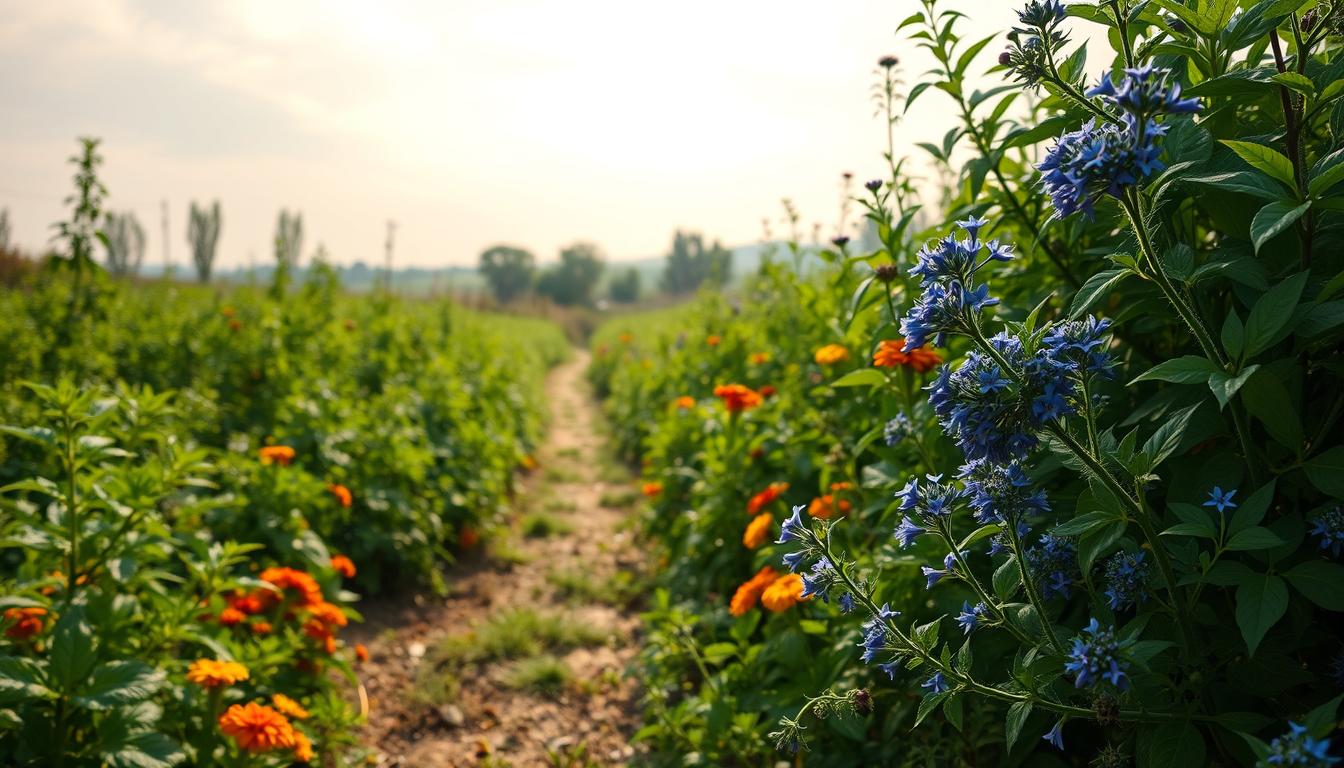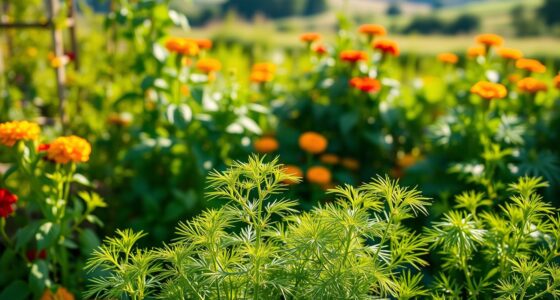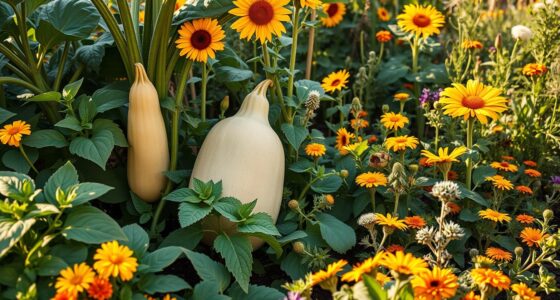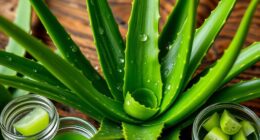Imagine stepping into your garden, a vibrant tapestry of colors and fragrances surrounding you. The sun peeks through the leaves, highlighting the delicate blooms and abundant greens. Wouldn’t it be wonderful if you could enhance this experience even further? By incorporating borage into your garden, not only can you beautify your space, but also unlock a world of benefits. Borage companion planting is a powerful technique that improves crop yields, invites beneficial insects, and acts as a natural pest deterrent. In this article, we’ll explore the numerous advantages of planting borage with other crops, helping you create a thriving garden ecosystem that nurtures both plants and pollinators alike. Let’s dive into the lush world of borage and discover how you can transform your gardening experience.
Key Takeaways
- Borage companion planting enhances garden vitality and performance.
- Borage attracts beneficial insects that support pollination.
- Planting borage with other crops improves overall yields.
- Borage acts as a natural pest deterrent.
- This article explores how to effectively incorporate borage into your garden.
- Discover the ideal borage plant companions for your garden.
What is Borage and Its Benefits for Gardens?
Borage is an annual herb that adds charm and functionality to any garden. Known for its striking star-shaped blue flowers and coarse green leaves, it serves multiple purposes, enhancing both aesthetics and plant health. Engaging with borage in companion gardening offers you a chance to foster a vibrant and productive garden environment.
Overview of Borage
This herb is not only visually appealing but is also packed with benefits. Borage thrives in a variety of conditions, making it a versatile choice for gardeners. Its growth pattern encourages space efficiency within your garden, allowing for better utilization of available areas.
Nutritional Benefits for Plants
Borage plays a significant role in improving nutrient availability in the soil. By planting borage alongside other crops, you introduce essential nutrients such as potassium and calcium that boost the growth and vitality of surrounding plants. These benefits of planting borage with other crops significantly enhance your garden’s productivity.
Attracting Beneficial Insects
Incorporating borage brings another valuable advantage: attracting beneficial insects. Its vibrant flowers allure bees and ladybugs, both paramount for pollination and natural pest control. This aspect of borage in companion gardening not only elevates the health of your plants but also fosters a balanced ecosystem, so you can enjoy the flourishing beauty of your garden.
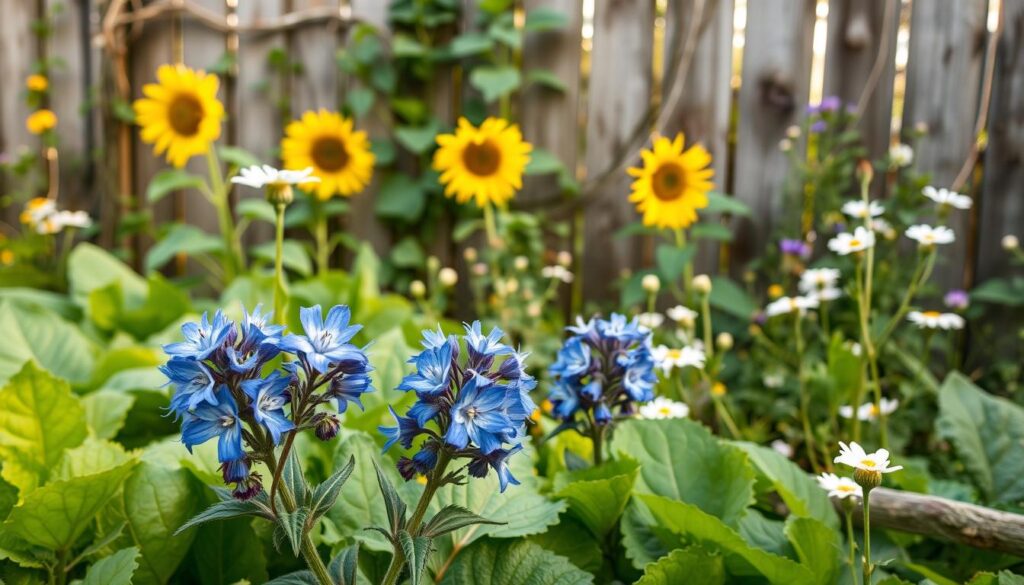
Ideal Companion Plants for Borage
Borage boasts numerous advantages in the garden, especially when paired with the right plants. Knowing the best plants to grow with borage helps in creating a vibrant and productive garden. Below are some ideal companions for borage, ensuring both aesthetic appeal and enhanced yields.
Herbs that Pair Well with Borage
Herbs can greatly benefit from interplanting borage. Varieties such as dill and parsley thrive when grown alongside borage, leading to an increase in flavor and vitality. These herbs not only enjoy the same growing conditions as borage but also help deter pests from the surrounding area.
Vegetables That Thrive Alongside Borage
Interplanting borage with vegetables is a great strategy for improving overall garden health. Tomatoes, strawberries, cucumbers, and various brassicas significantly benefit from borage’s presence. This dynamic duo not only boosts growth but also hinders pests like cabbage worms, making it a critical addition to your borage companion plants list.
Flowers Complementing Borage Growth
Incorporating flowers into your borage planting scheme enhances not just beauty but also ecological benefits. Bright flowers such as marigolds amplify the aesthetic appeal while offering nectar for beneficial pollinators. The combination of these complementary plants results in a thriving, colorful garden that draws in essential wildlife.
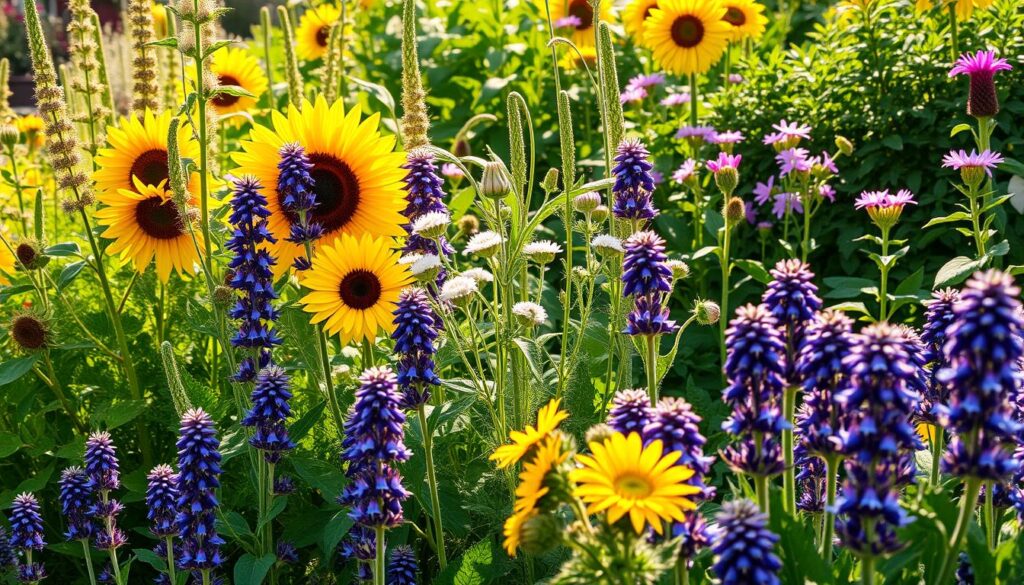
| Type | Companion Plant | Benefits |
|---|---|---|
| Herb | Dill | Boosts flavor and deters pests |
| Herb | Parsley | Enhances yields and attracts pollinators |
| Vegetable | Tomato | Improves growth and repels pests |
| Vegetable | Cucumber | Thrives harmoniously with borage |
| Flower | Marigold | Attracts beneficial insects and enhances aesthetics |
How Borage Enhances Soil Quality
Integrating borage into your garden can significantly improve soil quality. The plant’s unique characteristics contribute to a healthier garden ecosystem, which ultimately enhances the overall productivity of your crops. Understanding the specific benefits of planting borage with other crops reveals why it is an excellent choice for companion planting.
Nutrient-Rich Contributions
Borage acts as a natural fertilizer due to its ability to access nutrients deep within the soil. Its extensive root system draws up potassium, calcium, and magnesium, enriching the nearby soil. As these nutrients become available, neighboring plants benefit, resulting in a more robust garden.
Improving Soil Structure
One key feature of borage is its ability to improve soil structure. The plant creates a loose and airy environment, which promotes better aeration and drainage. This is particularly beneficial for other crops, as it reduces compaction and allows roots to grow more freely, leading to healthier plants overall.
Breaking Up Compact Soil
Borage is particularly effective at breaking up compact soil. As the roots grow, they penetrate the earth, helping to alleviate soil density. This process not only benefits the borage itself but also makes the growing environment easier for other plants, enhancing the advantages of planting borage with other crops.
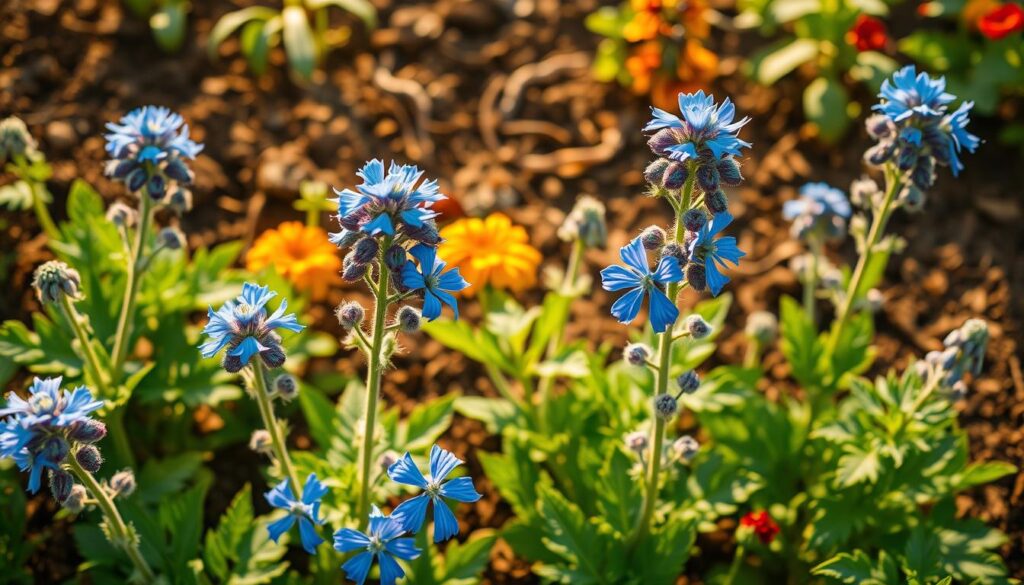
| Benefit | Description |
|---|---|
| Nutrient Availability | Borage increases nutrient access for nearby plants. |
| Soil Structure | Enhances aeration and drainage, creating a better growing environment. |
| Compaction Relief | Breaks up dense soil, allowing roots of other plants to penetrate more easily. |
Best Growing Conditions for Borage
Creating the perfect environment for your borage plant companions can significantly influence their growth and overall health. Understanding the optimal conditions helps you cultivate these vibrant herbs effectively. Here are the key aspects to consider for successful borage growth.
Sunlight Requirements
Borage thrives in full sun, needing at least six hours of sunlight each day. Although it can tolerate partial shade, ensuring ample sunlight exposure will enhance its growth and flowering. A sunny location in your garden will encourage robust borage plants that can flourish alongside their plant companions.
Soil Preferences
When selecting soil for borage, aim for well-draining, nutrient-rich options. Ideal soil pH levels range from 6.0 to 7.0. Amending the soil with compost can significantly boost nutrients, making it more suitable for borage and its neighboring plants. The right soil composition not only benefits borage but also enhances interactions with other borage plant companions.
Watering Guidelines
Consistent watering is essential, particularly for young borage plants. They require regular moisture to establish strong roots. As these plants mature, they become more resilient to drier conditions. Adjust your watering schedule based on the specific needs of your garden and the presence of other plants nearby. This flexibility allows borage to thrive alongside its chosen companions, contributing to a thriving ecosystem in your garden.
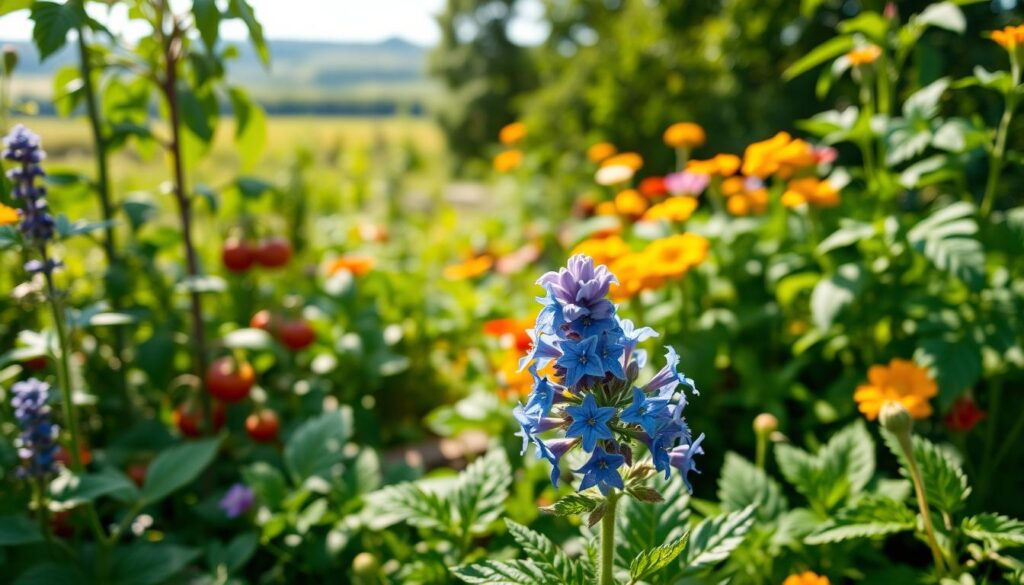
Seasonal Considerations for Planting Borage
Understanding the seasonal needs for borage enhances your garden’s effectiveness, especially when considering the best plants to grow with borage. Timing and care during the different seasons play a significant role in maximizing borage’s benefits in your garden.
When to Plant Borage in Your Garden
Plant borage after the last frost date when the soil temperatures are warm enough to support seed germination. This typically falls in late spring. You can start seeds outdoors or indoors a few weeks before the final frost. When planning your garden, remember that borage pairs well with the best plants to grow with borage, such as tomatoes and squash.
Seasonal Care Tips
Provide consistent watering throughout the growing season, especially during dry spells. Regularly check your plants for pests to maintain their health. Using natural pest deterrents can significantly benefit borage’s vibrant growth. Combining borage with the best plants to grow with borage helps create a balanced ecosystem that naturally combats unwanted pests.
Harvesting Borage Leaves and Flowers
For the freshest taste, harvest young leaves and vibrant flowers. They can enhance salads and beverages, adding a delightful touch to your culinary experiences. Picking leaves regularly encourages continued growth, ensuring your borage thrives throughout the season. Remember, the best plants to grow with borage will reap the rewards of timely harvesting, promoting an overall flourishing garden.

| Season | Actions | Best Plants to Grow With Borage |
|---|---|---|
| Spring | Plant seeds outdoors after the last frost | Tomatoes, Squash |
| Summer | Water regularly and monitor for pests | Cucumbers, Peppers |
| Autumn | Continue harvesting leaves and flowers | Carrots, Lettuce |
Pests and Diseases Affected by Borage
Understanding the relationship between borage and pests can greatly enhance your gardening experience. Many gardeners appreciate borage in companion gardening for its ability to deter pests while attracting beneficial insects. This unique characteristic makes it a valuable addition to any garden.
Naturally Deterring Pests
Borage is particularly effective in repelling harmful pests such as aphids and tomato hornworms. Its strong aroma acts as a natural deterrent, making it a preferred companion plant in many gardens. Tailoring your borage companion planting strategy to include plants that harmonize with borage can enhance its pest-repelling capabilities.
Common Diseases to Watch For
While diseases affecting borage are minimal, occasional cases of powdery mildew may occur. This disease often results from high humidity and poor air circulation. Monitoring your plants closely and ensuring proper spacing can prevent the spread of this issue.
Tips for Preventing Issues
Maintaining plant health is crucial for minimizing pests and diseases. Consider the following tips:
- Ensure adequate air circulation around borage plants.
- Avoid overhead watering to keep foliage dry.
- Regularly inspect plants for early signs of pest infestations or disease.
Implementing these preventive measures will create a healthier environment for your plants while reaping the benefits of borage in companion gardening.
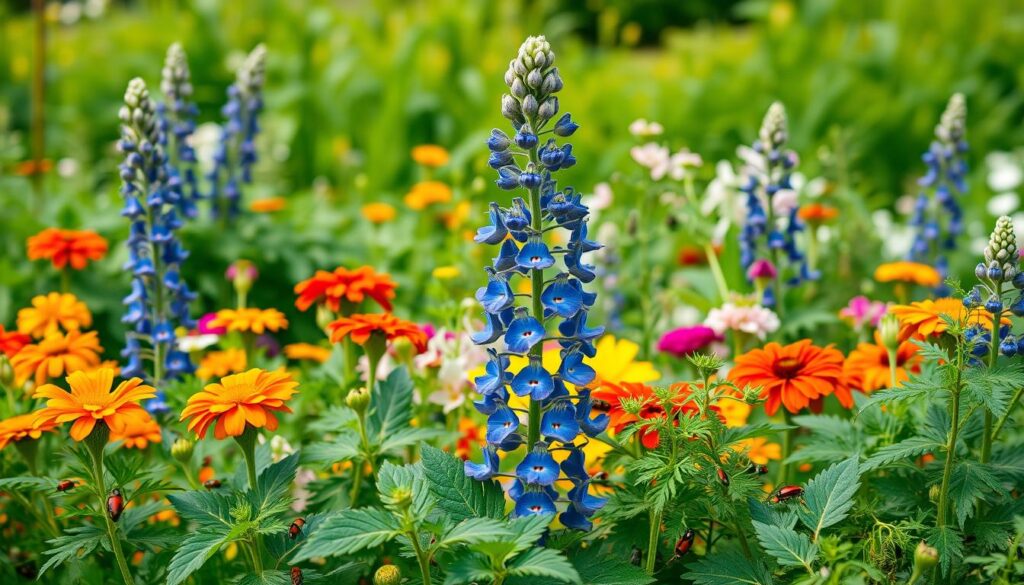
How to Incorporate Borage in Your Landscape Design
Borage not only enhances the beauty of your garden but also contributes to a biodiverse ecosystem. Utilizing a borage companion plants list can guide you in curating a visually stunning landscape while ensuring functional growth. By carefully considering how you use borage, you can uplift both aesthetic appeal and practical benefits in your garden.
Designing with Borage for Aesthetic Appeal
Incorporating borage into flower beds and vegetable patches adds a striking splash of color alongside its lush foliage. The star-shaped blue flowers can stand out beautifully against green leaves. Planting borage near your favorite flowers will create dynamic visuals in your garden, drawing attention from neighbors and guests alike.
Using Borage as Ground Cover
As a ground cover, borage effectively suppresses weeds while serving as a beautiful living mulch. Its sprawling growth habit helps to retain soil moisture and enhance soil quality. By integrating borage into your landscape, you will provide an attractive solution to prevent weed growth while enriching the surrounding soil.
Creating Pollinator-Friendly Spaces
Borage attracts an array of pollinators, enriching your garden’s ecosystem. Planting it in clusters not only enhances visual impact but also creates inviting habitats for bees and butterflies. Positioning your borage strategically throughout the garden offers multiple sources of nectar, contributing to a thriving pollinator-friendly space.
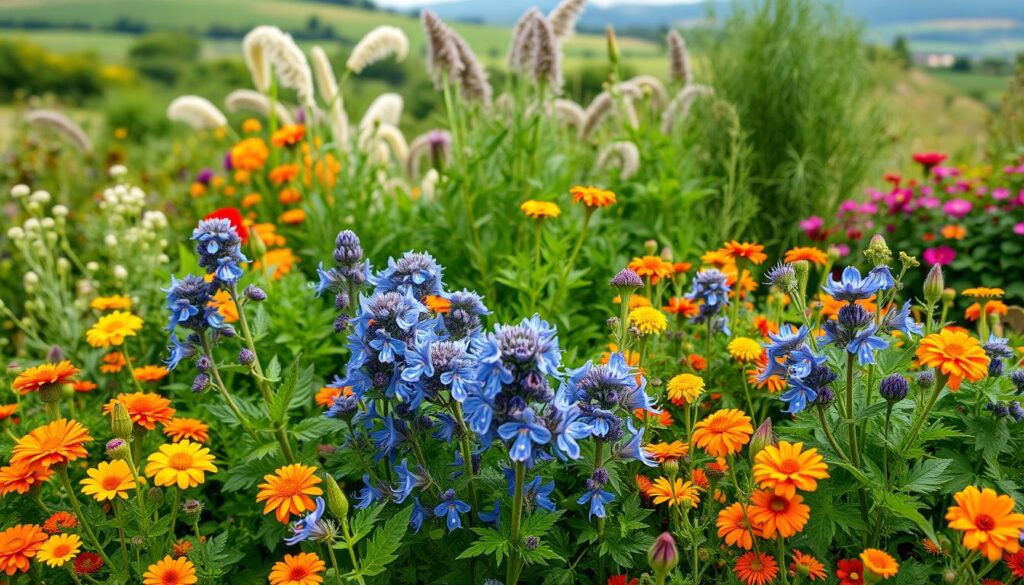
| Design Element | Description | Benefits |
|---|---|---|
| Aesthetic Appeal | Borage’s vibrant blue flowers and lush foliage create eye-catching visuals. | Attracts attention and enhances garden beauty. |
| Ground Cover | Borage grows wide and can cover soil effectively. | Suppresses weeds and retains soil moisture. |
| Pollinator Habitat | Clusters of borage flowers attract beneficial insects. | Supports biodiversity and aids in nearby plant pollination. |
Propagation Techniques for Borage
Successfully propagating borage can enhance your garden significantly. Whether you prefer growing from seeds or cuttings, each method has its own set of advantages. By understanding the best practices for successful growth, you can optimize your experience with this beneficial plant while exploring approaches like interplanting borage for maximum productivity.
Growing from Seeds
Borage is easily propagated from seeds, making it a popular choice among gardeners. You can sow seeds directly in your garden or start them indoors. Using transparent pots helps you monitor the growth closely. Make sure to keep the soil moist but not soggy, ensuring the seeds have optimal conditions for germination.
Propagating from Cuttings
For those interested in propagation through cuttings, selecting strong, healthy stems is crucial. Snip cuttings in the early morning for the best results. Place them in a suitable growing medium and keep them consistently watered to aid root development. Be mindful of spacing to allow borage to thrive without overcrowding, supporting best practices for successful growth.
Best Practices for Successful Growth
Maintaining regular watering schedules is essential for both seeds and cuttings. Ensure that borage has sufficient room to spread, as overcrowding can hinder growth. By following these guidelines, you’ll facilitate healthy propagation, leading to vibrant and thriving borage plants suited for interplanting with various companions.

Companion Planting Concepts Explained
Companion planting involves cultivating certain plants together based on their relationships, which can enhance growth and deter pests. Understanding the dynamics of these plant partnerships can elevate your gardening experience.
Understanding Companion Planting
Companion planting optimizes garden space by taking advantage of the natural synergies between different plants. Borage in companion gardening serves as a prime example, offering both nutritional benefits and attracting beneficial insects, which will enhance overall plant health.
The Science Behind Plant Relationships
Research supports the idea that certain plants can provide mutual advantages. For instance, borage releases nutrients into the soil, benefiting nearby plants and improving biodiversity. This creates a more resilient garden ecosystem, with each plant contributing to the larger environment.
Importance of Biodiversity in Gardens
Emphasizing biodiversity helps prevent pest outbreaks and disease. Borage in companion gardening not only attracts pollinators but also supports diverse plant life. A diverse garden fosters an ecological balance, benefiting both you and the plants in numerous ways.
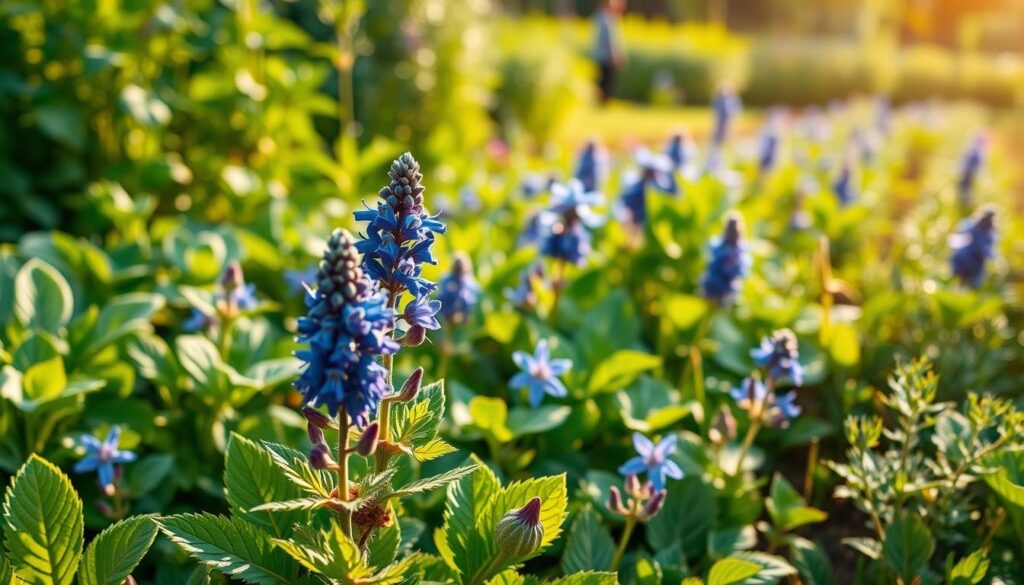
Troubleshooting Common Borage Issues
Growing borage can be a rewarding experience, yet it is not without its challenges. As you delve into the world of companion planting concepts, recognizing the signs of distress in your plants is crucial. Yellowing leaves and flower droppings often indicate underlying issues requiring your attention.
Yellowing Leaves and What They Mean
When leaves start to yellow, it could signal a nutrient deficiency, often linked to insufficient nitrogen or magnesium. Monitoring soil health is essential to ensure your borage thrives. Regularly testing your soil can help you identify any deficiencies and adjust your fertilization practices accordingly. Observing the neighboring plants within your companion planting scheme can also provide clues, as healthy plants often support one another.
Flower Dropping: Causes and Solutions
Flower dropping can be disheartening, especially when you’ve invested time in nurturing your borage. This problem may stem from factors like inadequate watering, temperature fluctuations, or stress from pests. Implementing a consistent watering schedule can mitigate watering stress. Observing your plants regularly allows you to spot potential pests early and take preventive measures. Applying the principles of companion planting can enhance resilience, creating a more balanced ecosystem.
When to Seek Professional Advice
Despite your best efforts, some issues may persist. If you notice continual yellowing leaves or flower dropping after trying various solutions, it may be time to seek professional advice. A gardening expert can provide targeted support to help restore your borage’s health. Understanding these common issues and seeking guidance when needed ensures that you can fully enjoy the benefits of companion planting concepts in your garden.

Human Uses of Borage
Borage is a remarkable plant that transcends its role in the garden, offering culinary and medicinal benefits. This herb has found its way into various kitchens and apothecaries due to its unique properties and uses. Understanding the culinary applications of borage can enhance your dishes and provide you with insights into its historical significance.
Culinary Applications of Borage
The leaves and flowers of borage are not only attractive but also flavorful. Their cucumber-like taste adds a refreshing touch to salads, drinks, and desserts. Consider these popular uses:
- Adding fresh borage leaves to salads for a delightful crunch.
- Infusing borage flowers in beverages, such as iced tea or cocktails.
- Garnishing desserts for both taste and visual appeal.
Medicinal Uses Throughout History
Borage has a rich history as a medicinal herb, often used in herbal remedies. It has been known to help alleviate various ailments, such as:
- Soothing anxiety due to its calming effects.
- Relieving respiratory issues with its anti-inflammatory properties.
- Improving skin health when used in topical preparations.
Making Borage-Infused Products
Creativity in the kitchen can lead to innovative borage-infused products. Here’s how you can utilize this plant:
- Make borage-infused oil for skin care, harnessing its moisturizing properties.
- Create herbal teas by steeping dried borage leaves.
- Prepare flavored syrups using borage flowers for unique cocktail mixes.
The versatility of borage extends to its integration with other crops, providing additional benefits of planting borage with other crops, such as pest control and nutrient enhancement.
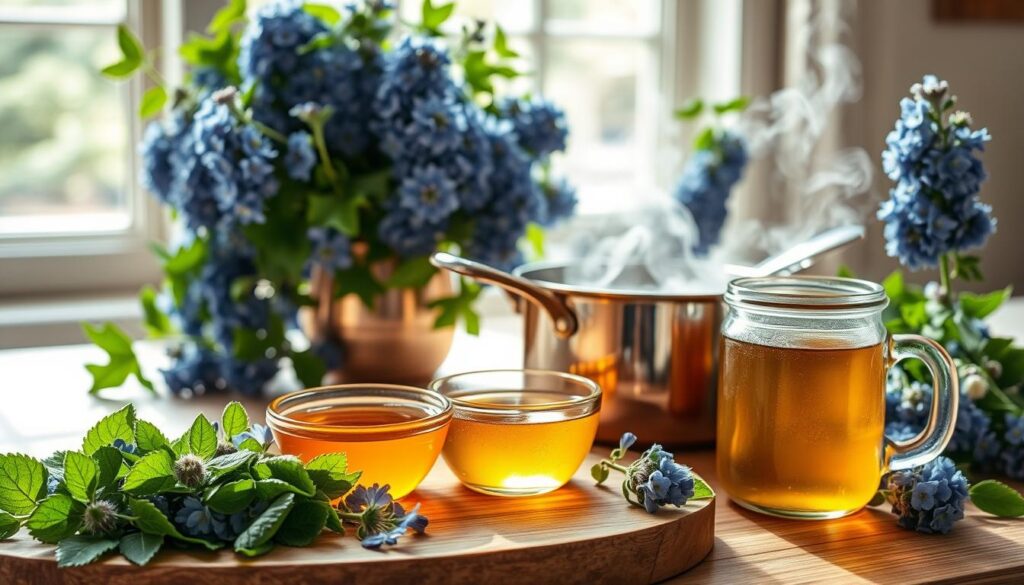
| Use | Description |
|---|---|
| Culinary | Enhances flavors in dishes and beverages. |
| Medicinal | Historically used for calming and anti-inflammatory effects. |
| Infused Products | Used in oils, teas, and syrups for various applications. |
Borage Varieties to Explore
Borage offers a diverse range of species that cater to different gardening preferences and needs. Each variety presents unique characteristics, growth habits, and benefits, making it essential to explore your options when considering borage plant companions. Here’s a closer look at some common and unique borage varieties.
Common Borage Species
The most widely known species is Borago officinalis, often simply referred to as borage. This variety features vibrant blue star-shaped flowers that are not only beautiful but also attract beneficial pollinators. Another popular option is Borago macrophylla, which boasts larger leaves and a more bushy appearance, making it an excellent choice for filling out garden beds alongside other plants.
Unique Varieties for Different Gardens
For those looking to experiment, unique hybrids of borage offer interesting alternatives. Varieties such as Borago ‘Blue Ice’ present striking white flowers, providing a stunning contrast in gardens. There are even dwarf varieties available that fit well in smaller spaces, allowing them to be effective borage plant companions without overwhelming other plants.
Choosing the Right Type for Your Needs
When selecting the right borage variety, consider factors like the size of your garden, the type of plants you wish to grow alongside borage, and your personal aesthetic preferences. Collecting information on each species enhances your ability to incorporate borage effectively, ensuring harmonious interactions with your borage plant companions.
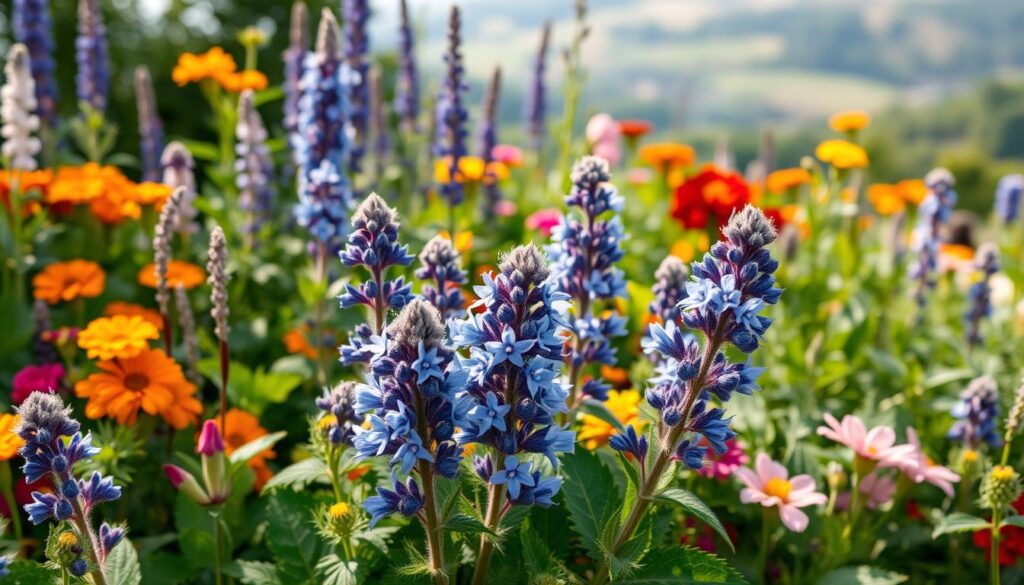
Planning Your Companion Planting Strategy
Creating a successful companion planting strategy necessitates careful consideration and planning. You can enhance your gardening experience by implementing practical techniques that focus on the relationships between various plants. Understanding the benefits of borage companion planting helps to optimize your garden layout, maximizing light exposure and available space.
Tips for Companion Planting Success
To achieve success in companion planting, consider the following tips:
- Choose plants that support each other’s growth and deter pests.
- Utilize vertical space to prevent overcrowding and promote airflow.
- Regularly monitor plant health and adjust layouts as needed.
Mapping Out Your Garden Layout
Effective mapping out your garden layout is crucial for a thriving companion planting scheme. Begin by sketching your garden space and identifying the sunlight patterns throughout the day. This allows you to position taller plants to the north, so they do not overshadow shorter plants. Incorporate borage strategically to make the most of its beneficial properties and maximize growth potential.
Evaluating Plant Interactions
Evaluating plant interactions is a vital aspect of companion planting. Each plant has different needs, and understanding these can lead to improved health and productivity. For instance, borage not only attracts beneficial insects but also enhances nutrient uptake for nearby plants. Documenting these interactions as you garden can help refine your methods over time.
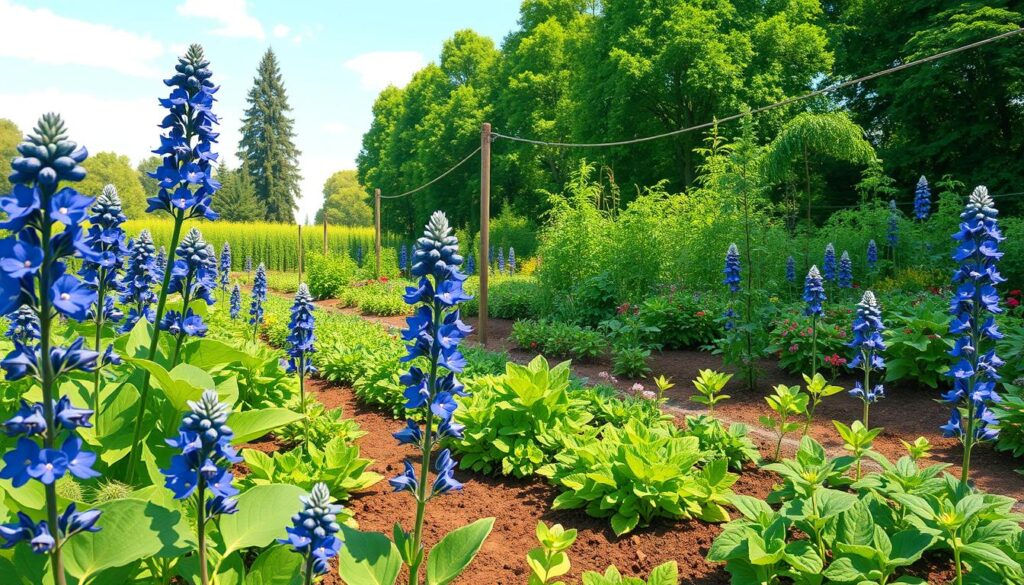
Borage Maintenance Throughout Growing Season
Effective borage maintenance ensures that your plants thrive throughout the growing season. Regular care, proper pruning techniques, and timely preparations for winter help sustain the health and beauty of your borage. By paying attention to these aspects, you can enjoy a vibrant display of flowers and robust plant growth.
Regular Care and Feeding
Monitor the watering needs of your borage regularly. These plants flourish with consistent moisture, so check the soil to determine when to water. Applying organic fertilizers can significantly bolster growth. Choose a balanced fertilizer that provides essential nutrients, promoting lush foliage and abundant blooms.
Pruning and Deadheading Tips
To encourage continuous blooming, practice deadheading by removing spent flowers. This will redirect energy to new growth. Pruning is equally crucial; trim back any leggy or overgrown stems. This not only enhances the plant’s appearance but also promotes better air circulation, reducing the risk of disease.
Preparing Borage for Winter
As colder months approach, preparing borage for winter is key to its survival. Trim back the plant to prevent any damage from frost. Mulching around the base can further protect the roots. This layer helps insulate the plants against temperature fluctuations, ensuring they remain strong for the upcoming season.
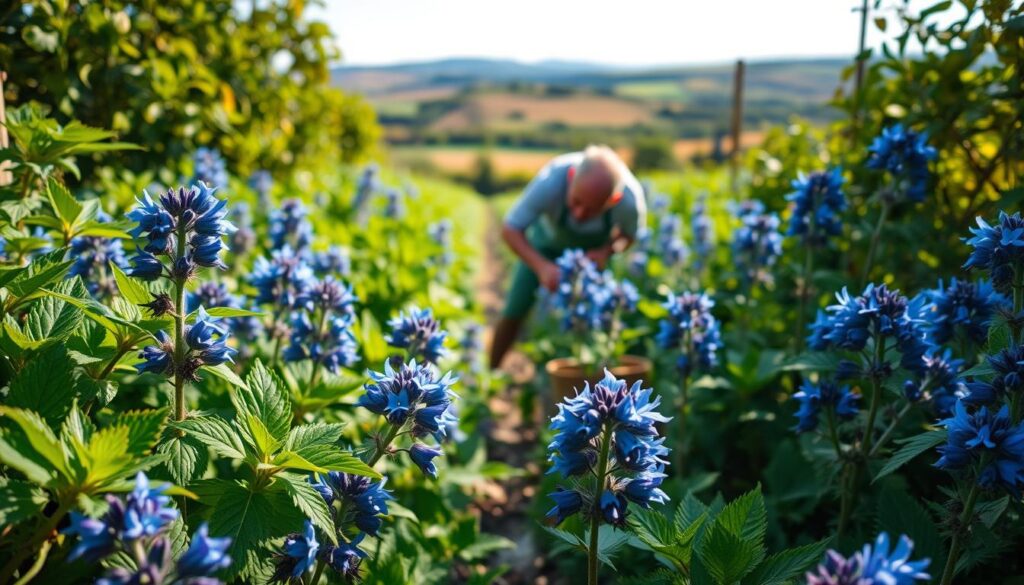
Benefits of Growing Borage for You
Growing borage in your garden can provide a host of benefits that enhance your gardening experience. This vibrant plant not only supports the growth of its companions but also enriches the garden ecosystem. Incorporating borage could lead to fruitful gardening endeavors and environmental benefits.
Enhancing Your Gardening Experience
When you cultivate borage alongside other crops, you can experience the benefits of planting borage with other crops firsthand. This plant attracts bees and other beneficial insects, contributing to pollination and encouraging a thriving garden environment. Creating a borage companion plants list can help you plan your garden layout effectively, allowing borage to work synergistically with herbs and vegetables.
Environmental Advantages
Borage plays a significant role in promoting biodiversity and improving soil health. As borage grows, it contributes essential nutrients, fostering better conditions for neighboring plants. This plant’s deep roots break up compact soil, enhancing aeration and water retention capabilities. These features make borage an indispensable addition to sustainable gardening practices.
Personal Well-Being Through Gardening
Gardening with borage can also positively impact your personal well-being. Engaging in this activity offers a meditative experience that encourages you to connect with nature, reducing stress and promoting relaxation. Including borage in your gardening routine enriches not just your garden but your overall quality of life as well.
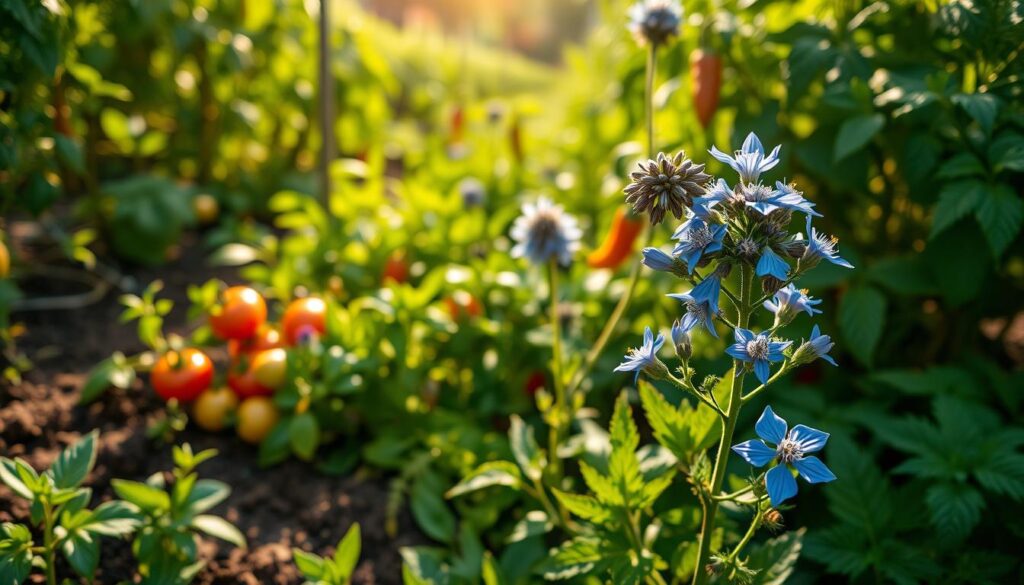
Final Thoughts on Borage Companion Planting
As you explore the world of borage companion planting, remember the multitude of benefits this remarkable herb brings to your garden. From enhancing soil quality and attracting beneficial insects to pairing beautifully with various plants, incorporating borage can elevate your gardening experience. The virtues of borage are numerous, making it a steadfast companion to many herbs, vegetables, and flowers.
Now is the perfect time to get started with your borage growing journey. Whether you’re a seasoned gardener or new to planting, embracing borage can add both beauty and functionality to your garden. Don’t hesitate to experiment with different companion plants and witness how borage enhances their growth and vigor.
Joining a community of fellow gardening enthusiasts can significantly enrich your borage companion planting experience. By sharing tips, triumphs, and challenges, you can cultivate a network of knowledge that supports your gardening endeavors. So, grab your seeds and get ready to create a thriving garden with borage at its heart!
